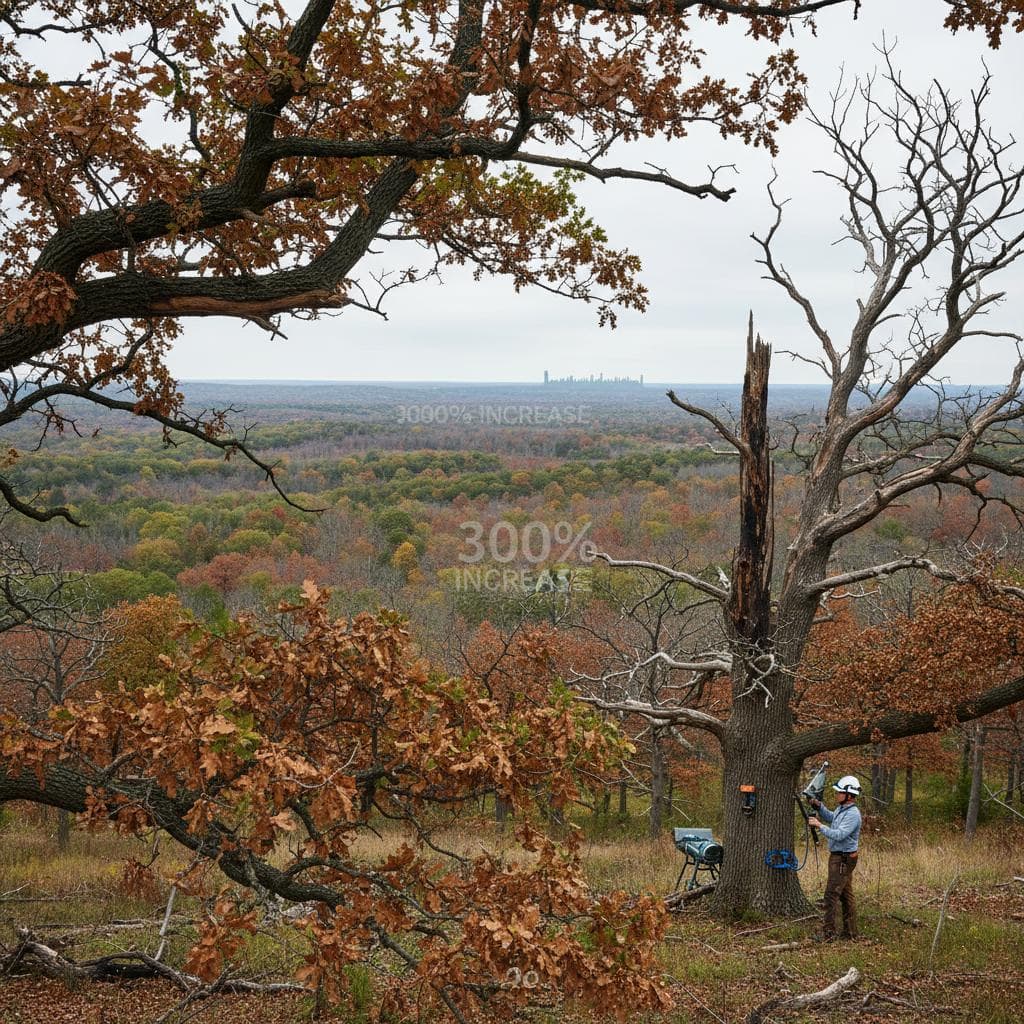Oak Wilts 300 Percent Surge: A Growing Threat from Texas to Minnesota in 2025
Oak wilt spreads at an alarming rate, with reports indicating a 300 percent rise in cases throughout the central United States. This fungal disease now endangers vast oak forests stretching from Texas to Minnesota. Without intervention, it can fell a mature oak in mere weeks, resulting in dangerous fallen branches and expensive cleanup for property owners.
Warm and humid weather patterns, combined with pruning during high-risk periods, fuel this escalation. Property owners and land stewards need to identify and isolate affected trees promptly to halt the spread via roots and insects to unaffected specimens.
Understanding Oak Wilt and Its Impact
Oak wilt arises from the fungus Bretziella fagacearum, which clogs the trees vascular tissues and disrupts water flow. Leaves wilt rapidly, turn discolored, and lead to full tree mortality. Red oaks succumb most quickly, often within one month, whereas white oaks resist longer yet deteriorate once roots become involved.
The pathogen propagates through two primary channels. Root grafts connect adjacent trees of the same species underground. Sap-feeding beetles then transport spores from diseased trees to open cuts on healthy ones. Such mechanisms enable swift outbreaks that can ravage community groves or wooded areas without swift preventive actions.
Drivers of the 300 Percent Increase
Environmental shifts and human practices contribute to the rapid proliferation of oak wilt in Midwestern and southern regions. Property owners can mitigate risks by grasping these elements.
- Weather fluctuations: Prolonged dampness succeeded by high temperatures fosters fungal proliferation and beetle proliferation.
- Seasonal pruning errors: Trimming during peak beetle activity exposes fresh cuts that draw in spore carriers.
- Interconnected roots: Thick oak groupings link via subsurface networks, permitting undetectable disease transmission.
- Delayed recognition: Owners often confuse initial signs with drought or routine ailments, postponing essential responses.
- Tree vulnerabilities: Construction, compacted soil, and altered watering routines compromise tree health, heightening infection susceptibility.
Identifying Oak Wilt Symptoms Early
Timely spotting proves essential, as no straightforward remedy exists once the fungus invades the vascular core. Monitor for these indicators:
- Discoloration in leaves, originating at tips or margins and advancing toward the central vein.
- Early leaf fall in summer, featuring browned or bronzed foliage beneath the branches.
- Drooping or rolled leaves that cling to stems.
- Mats of fungus beneath the bark of freshly deceased red oaks, releasing a sweet, fermented scent to lure beetles.
- Sudden canopy loss, particularly among red oak clusters.
A single trees swift decline signals potential peril for surrounding oaks.
Strategies for Treatment and Containment
Certified arborists deploy barriers, chemicals, and cleanup protocols tailored to infection scale and tree proximity.
Root Trenching Techniques
Excavation severs underground connections that facilitate fungal travel. Specialists operate heavy machinery to carve trenches at minimum four feet depth encircling diseased trees, thereby segregating them from vital neighbors.
Fungicide Application Methods
Propiconazole-based treatments safeguard nearby uninfected oaks amid outbreaks. Arborists inject the solution into trunks for systemic distribution that curbs pathogen advancement. Applications provide protection for two to three years, requiring subsequent doses.
Removal and Safe Disposal
Heavily afflicted trees demand felling to curb dissemination. Operators debark and solar-dry the timber on-site to eliminate spore risks. Transporting or storing untreated wood invites broader contamination.
Maintenance and Proactive Measures
Disinfect tools between uses, restrict pruning to inactive beetle phases, and apply sealants to unintended injuries. Provide thorough irrigation to stressed oaks during arid conditions to bolster natural defenses.
Weighing DIY Approaches Against Professional Services
Homeowners occasionally attempt self-management, yet oak wilt demands expertise and tools beyond casual reach. Accurate assessment, precise isolation, and secure chemical use fall outside typical DIY scope. Engaging a certified arborist ensures correct identification, optimal strategy, and hazard-free execution, averting greater financial losses from widespread tree failure.
Untrained efforts at trimming or extraction pose safety hazards. Mature oaks topple unpredictably, and excavation risks utility lines or adjacent buildings. Confirm that any hired service holds valid insurance and credentials for pathogen control.
Selecting a Reliable Arborist
The choice of expert profoundly influences containment success. Prioritize these attributes:
- ISA credentials: Such certification denotes rigorous education in arboriculture, pathology, and protocols.
- Proven oak wilt handling: Inquire about prior containment efforts to gauge familiarity.
- Specialized gear: Expect trenchers, injection kits, and sanitized implements.
- Comprehensive insurance: Secure proof of general liability and employee protection prior to commencement.
- Clear pricing: Trustworthy firms furnish itemized proposals detailing steps and expenses.
Skilled professionals further advise on ongoing safeguards, such as safe pruning windows and vigilant monitoring.
Common Questions on Oak Wilt Management
How rapidly does oak wilt progress to tree death?
Infection claims red oaks in weeks, while white oaks endure months to years. Progression hinges on variety, climate, and intervention timing.
Does oak wilt affect non-oak species?
The disease targets solely oaks and kin within the Quercus family. Still, oak losses unsettle habitats dependent on their canopy and mast.
Exists a definitive cure for oak wilt?
Advanced infections lack full reversal, though fungicides and trenching preserve adjacent trees if applied early. Prevention surpasses remediation in efficacy.
What periods suit oak pruning best?
Limit cuts to dormancy when beetles remain scarce. Steer clear of spring through early summer peaks.
What expenses accompany professional interventions?
Fees range from hundreds to thousands of dollars, influenced by tree count, trenching scope, and treatment volume.
Is immediate removal necessary for dead oaks?
Affirmative. Lingering corpses sustain spores; swift clearance and disposal shield neighbors.
How to differentiate oak wilt from similar declines?
Arborists diagnose via examination or lab analysis. Conditions like rot or desiccation imitate symptoms, underscoring expert verification.
Safeguarding Oaks for Lasting Landscapes
Implementing these practices not only curbs oak wilt but also fortifies community greenery against future threats. Consult local extension services for region-specific alerts and support your trees through vigilant care. Healthy oaks enhance property appeal, support wildlife, and sustain the regions natural heritage.
